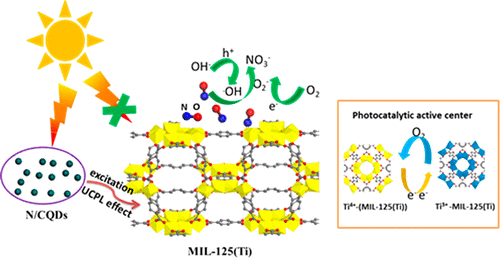当前位置:
X-MOL 学术
›
Ind. Eng. Chem. Res.
›
论文详情
Our official English website, www.x-mol.net, welcomes your
feedback! (Note: you will need to create a separate account there.)
Novel N/Carbon Quantum Dot Modified MIL-125(Ti) Composite for Enhanced Visible-Light Photocatalytic Removal of NO
Industrial & Engineering Chemistry Research ( IF 3.8 ) Pub Date : 2020-03-25 , DOI: 10.1021/acs.iecr.9b06816 Meijuan Chen 1, 2, 3 , Xiaoyan Wei 2 , Liaoliao Zhao 2, 4 , Yu Huang 2 , Shun-cheng Lee 5 , Wingkei Ho 6 , Kehao Chen 3
Industrial & Engineering Chemistry Research ( IF 3.8 ) Pub Date : 2020-03-25 , DOI: 10.1021/acs.iecr.9b06816 Meijuan Chen 1, 2, 3 , Xiaoyan Wei 2 , Liaoliao Zhao 2, 4 , Yu Huang 2 , Shun-cheng Lee 5 , Wingkei Ho 6 , Kehao Chen 3
Affiliation

|
Highly efficient and stable photocatalysts were synthesized at room temperature by modifying MIL-125(Ti) with N-doped carbon quantum dots (N/CM(Ti)). The N/CM(Ti) with 2.5 vol % N doped carbon quantum dots (N/CQDs) had the best light absorption and visible-light photocatalytic nitrogen oxide (NO) removal efficiency (approximately 49%). It was found through X-ray photoelectron spectroscopy analysis that a N–Ti–O bond was formed in the 2.5 vol % N/CM(Ti), which is more conducive to charge transfer. Photocurrent and electrochemical impedance data also showed that the carrier separation efficiency of 2.5 vol % N/CM(Ti) was significantly superior to that of MIL-125(Ti). In addition, the TiIII–TiIV of MIL-125(Ti) acts as the active center for photocatalytic removal of NO. Two possible electron migration paths were proposed: electron transfer from N/CQDs to TiIII–TiIV center of MIL-125(Ti) due to the photoinduced electron transfer property of N/CQDs, and absorption of UV light generated from the N/CQDs by the terephthalic acid ligand followed by electron transfer to metal active sites for photocatalytic removal of NO.
中文翻译:

新型N /碳量子点修饰的MIL-125(Ti)复合材料,用于增强可见光对NO的光催化去除
通过用N掺杂的碳量子点(N / CM(Ti))修饰MIL-125(Ti),在室温下合成了高效稳定的光催化剂。具有2.5%(体积)N掺杂碳量子点(N / CQDs)的N / CM(Ti)具有最佳的光吸收和可见光光催化氮氧化物(NO)去除效率(约49%)。通过X射线光电子能谱分析发现,在2.5%(体积)的N / CM(Ti)中形成了N-Ti-O键,这更有利于电荷转移。光电流和电化学阻抗数据还表明,2.5体积%N / CM(Ti)的载流子分离效率显着优于MIL-125(Ti)。此外,Ti III –Ti IVMIL-125(Ti)的活性中心充当光催化去除NO的活性中心。提出了两种可能的电子迁移路径:由于N / CQDs的光致电子转移特性,电子从N / CQDs转移到MIL-125(Ti)的Ti III -Ti IV中心,以及吸收N / CQDs产生的UV光。通过对苯二甲酸配体生成CQD,然后电子转移到金属活性位点以光催化去除NO。
更新日期:2020-03-26
中文翻译:

新型N /碳量子点修饰的MIL-125(Ti)复合材料,用于增强可见光对NO的光催化去除
通过用N掺杂的碳量子点(N / CM(Ti))修饰MIL-125(Ti),在室温下合成了高效稳定的光催化剂。具有2.5%(体积)N掺杂碳量子点(N / CQDs)的N / CM(Ti)具有最佳的光吸收和可见光光催化氮氧化物(NO)去除效率(约49%)。通过X射线光电子能谱分析发现,在2.5%(体积)的N / CM(Ti)中形成了N-Ti-O键,这更有利于电荷转移。光电流和电化学阻抗数据还表明,2.5体积%N / CM(Ti)的载流子分离效率显着优于MIL-125(Ti)。此外,Ti III –Ti IVMIL-125(Ti)的活性中心充当光催化去除NO的活性中心。提出了两种可能的电子迁移路径:由于N / CQDs的光致电子转移特性,电子从N / CQDs转移到MIL-125(Ti)的Ti III -Ti IV中心,以及吸收N / CQDs产生的UV光。通过对苯二甲酸配体生成CQD,然后电子转移到金属活性位点以光催化去除NO。











































 京公网安备 11010802027423号
京公网安备 11010802027423号